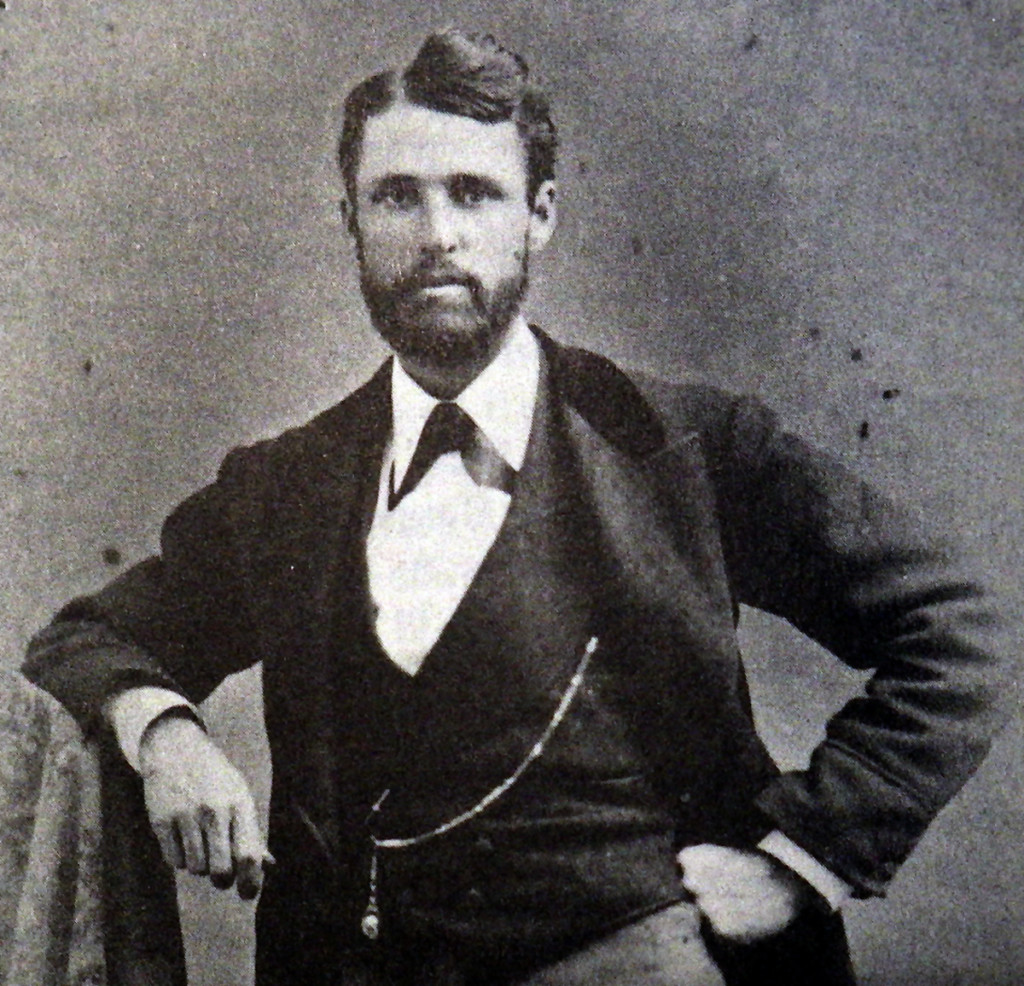
As you have already learned, Dr. Winchester was a fine, upstanding citizen, held in high regard by even the most elite in early Santa Barbara.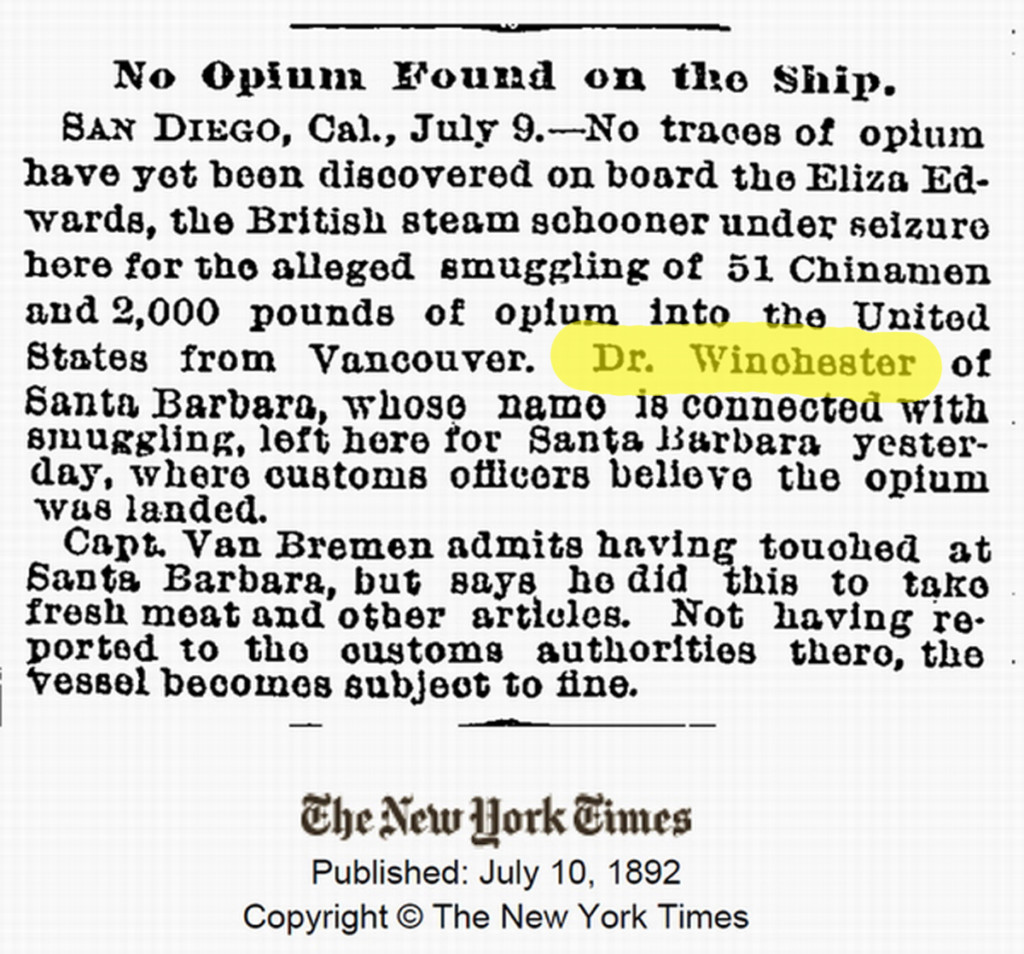 So imagine the eyebrows being raised when newspapers all across the country accused him of smuggling opium and illegal aliens!
So imagine the eyebrows being raised when newspapers all across the country accused him of smuggling opium and illegal aliens!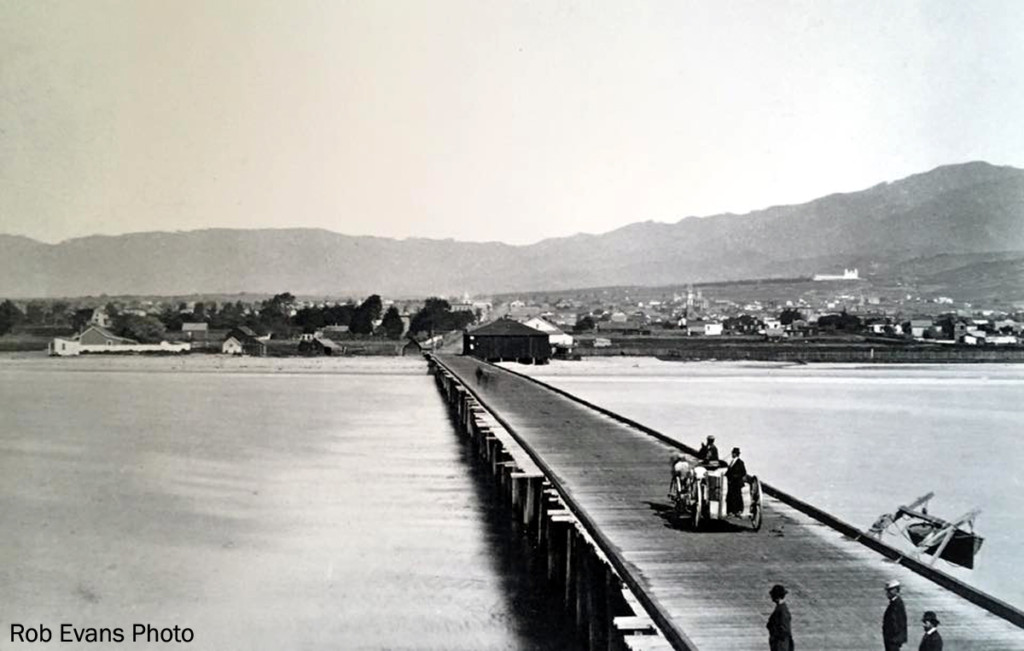 According to the Los Angeles Times on July 10th, 1892, Winchester had been under constant surveillance by Federal officers since his return from a mysterious trip to Vancouver. They watched as Winchester and a Captain Van Bremen were picked up by a buggy at Stearns Wharf.
According to the Los Angeles Times on July 10th, 1892, Winchester had been under constant surveillance by Federal officers since his return from a mysterious trip to Vancouver. They watched as Winchester and a Captain Van Bremen were picked up by a buggy at Stearns Wharf.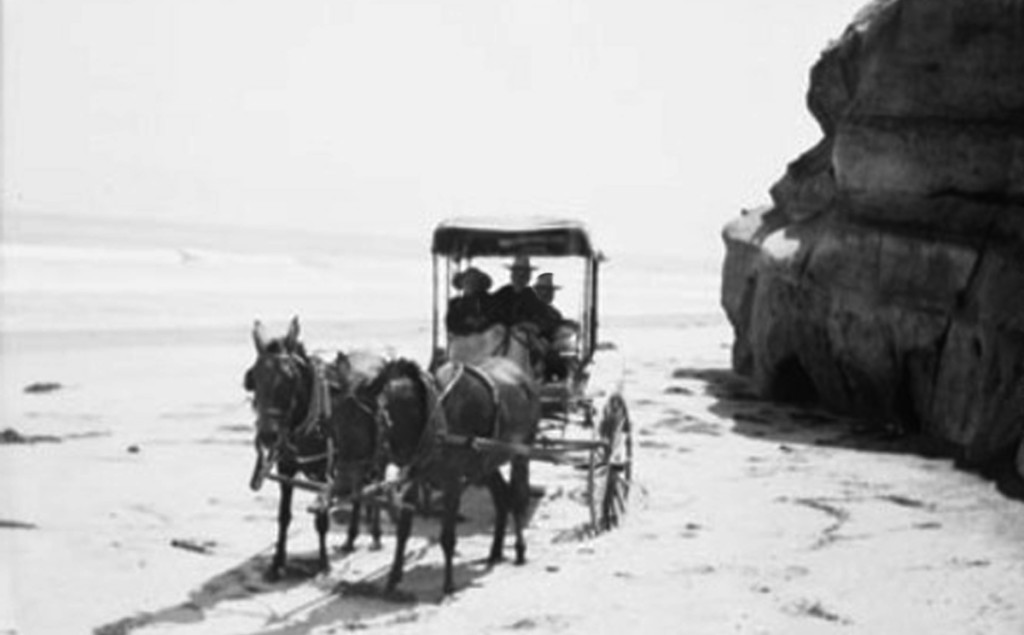 The pair were taken down the beach to a point on the shore directly opposite a mysterious vessel at anchor in the fog. The driver that took them was “silent as an oyster” when questioned about the identity of the ship. It was evident he had been cautioned to say as little as possible.
The pair were taken down the beach to a point on the shore directly opposite a mysterious vessel at anchor in the fog. The driver that took them was “silent as an oyster” when questioned about the identity of the ship. It was evident he had been cautioned to say as little as possible.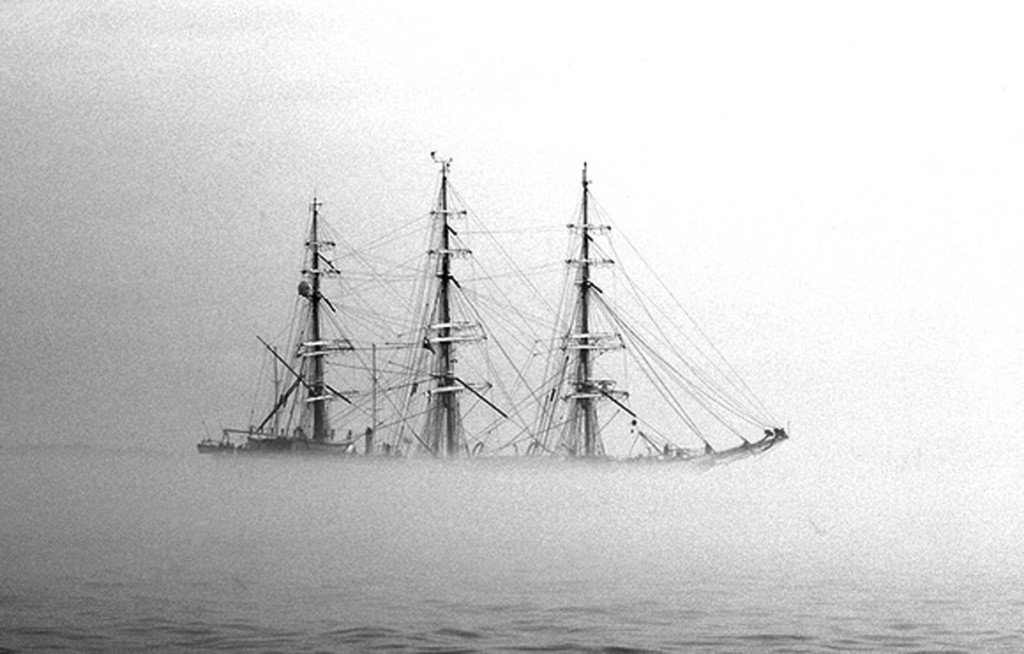 Customs officers knew that this same ship, the Eliza Edwards, had sailed from Vancouver, but had made an unscheduled stop at Victoria. There, it met with a sloop and appeared to take on cargo, arousing officials’ suspicions. Now the ship sat and waited just off the bluffs in front of the Santa Barbara cemetery. A boat from the ship was landed on the beach and the occupants held a long conversation and exchanged objects with the Doctor and the Captain.
Customs officers knew that this same ship, the Eliza Edwards, had sailed from Vancouver, but had made an unscheduled stop at Victoria. There, it met with a sloop and appeared to take on cargo, arousing officials’ suspicions. Now the ship sat and waited just off the bluffs in front of the Santa Barbara cemetery. A boat from the ship was landed on the beach and the occupants held a long conversation and exchanged objects with the Doctor and the Captain.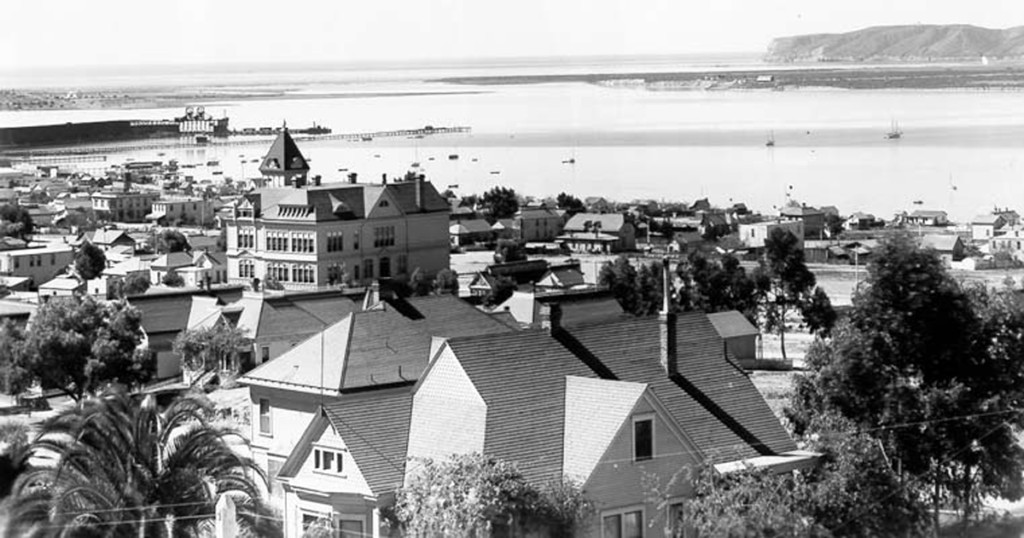 Soon after, Winchester reportedly left for the East coast with a stranger. But he actually went no further than San Diego, and checked into a hotel as “Charles H. Smith of Chicago”. This is not looking good for our esteemed physician….Why would this mysterious ship not land at the wharf, and instead quietly cast anchor in a fog bank off shore? And why was her presence not reported to the Federal officer in Santa Barbara as was required by the law? And why did it make an unscheduled stop in Canada and meet with another ship? And why did the doctor say he was heading east, and then check into a San Diego hotel under a false name?
Soon after, Winchester reportedly left for the East coast with a stranger. But he actually went no further than San Diego, and checked into a hotel as “Charles H. Smith of Chicago”. This is not looking good for our esteemed physician….Why would this mysterious ship not land at the wharf, and instead quietly cast anchor in a fog bank off shore? And why was her presence not reported to the Federal officer in Santa Barbara as was required by the law? And why did it make an unscheduled stop in Canada and meet with another ship? And why did the doctor say he was heading east, and then check into a San Diego hotel under a false name?
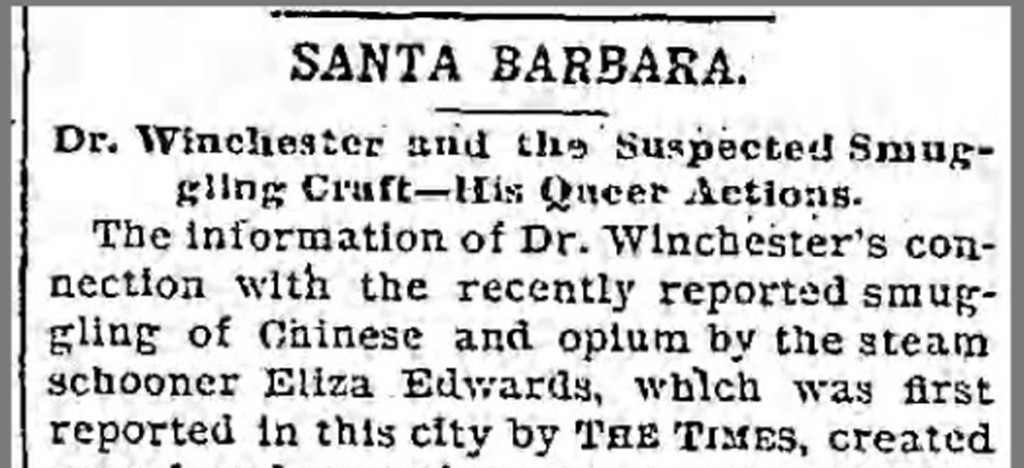
The L.A. Times labeled Winchester’s behavior queer, and left readers with an impression of definite wrongdoing. The ship was seized in San Diego by Customs officials and searched thoroughly as the media threw around wild, unconfirmed speculations.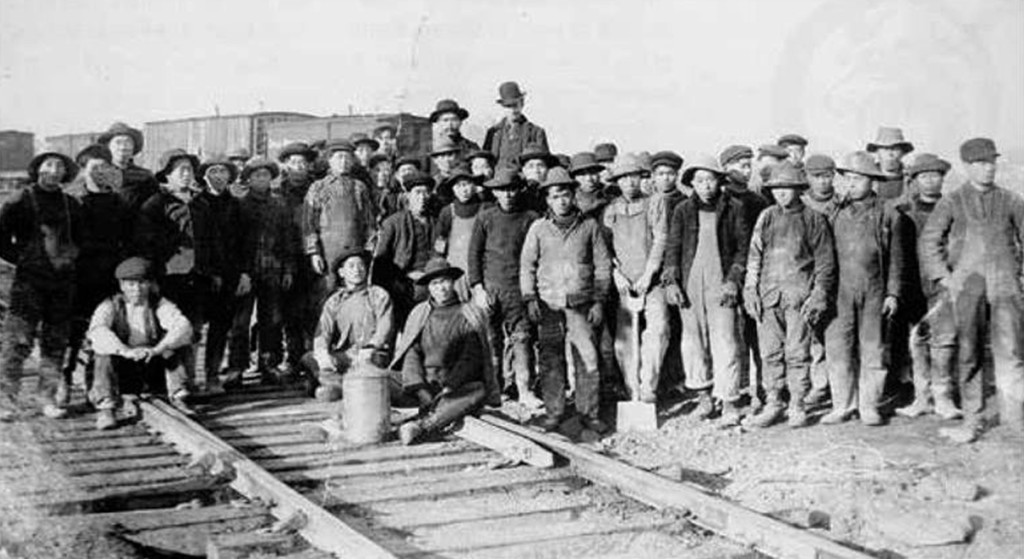 Some background on why smuggling was such a hot topic in these days: Chinese immigration had started in California with the Gold Rush in 1848. Hard times in China prompted many young males to come work in California and send money back home to their families. When the gold dried up, the railroads hired the Chinese as cheap labor to expand their lines around the country. More than 300,000 Chinese came to the U.S. between 1850 and 1882. When the railroads were done, Chinese immigrants became the target of a wave of violence and discrimination in California.
Some background on why smuggling was such a hot topic in these days: Chinese immigration had started in California with the Gold Rush in 1848. Hard times in China prompted many young males to come work in California and send money back home to their families. When the gold dried up, the railroads hired the Chinese as cheap labor to expand their lines around the country. More than 300,000 Chinese came to the U.S. between 1850 and 1882. When the railroads were done, Chinese immigrants became the target of a wave of violence and discrimination in California.
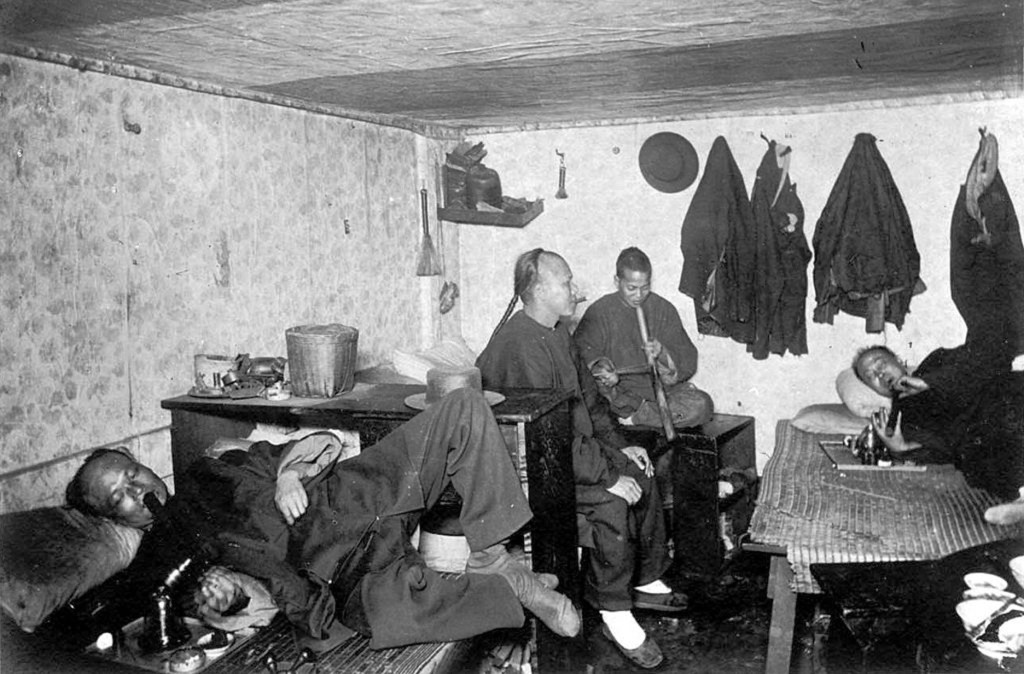 Meanwhile, a byproduct of the Chinese culture was flourishing; opium. There was big money to be made in the opium market, providing the addictive drug to its growing audience. And not just for the Chinese…..
Meanwhile, a byproduct of the Chinese culture was flourishing; opium. There was big money to be made in the opium market, providing the addictive drug to its growing audience. And not just for the Chinese….. 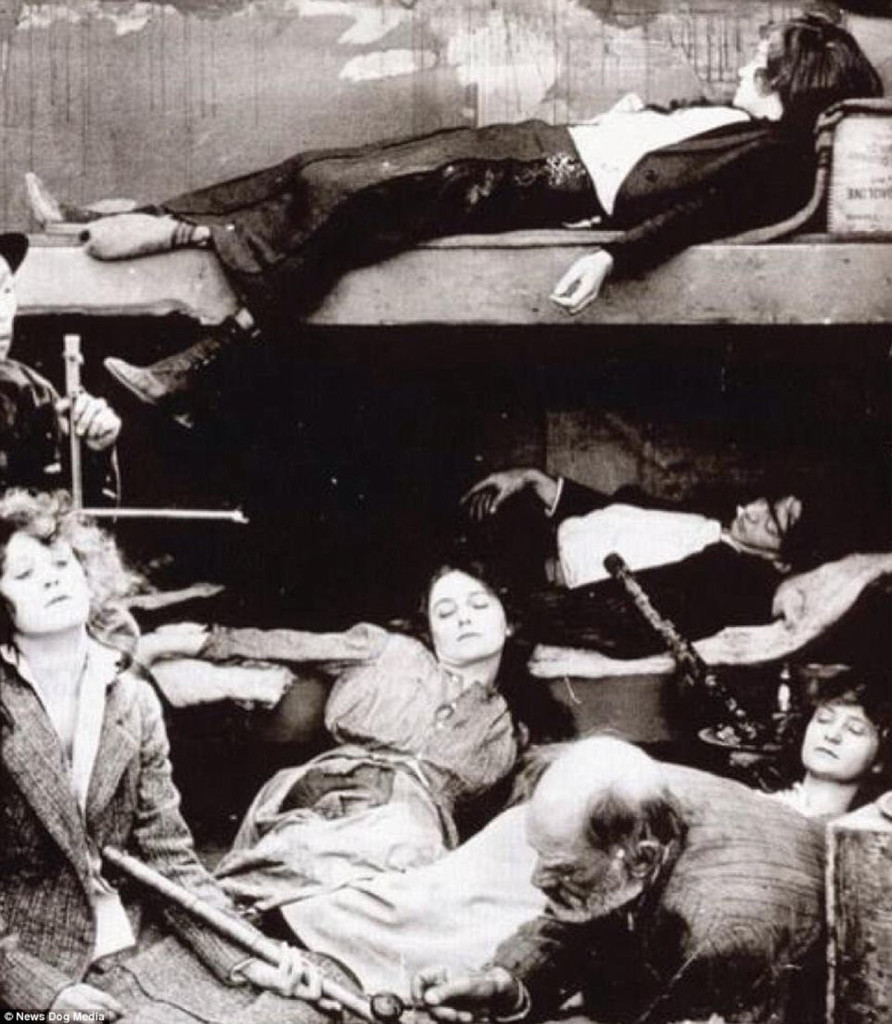 Opium became “in” with the “in crowd”. White middle and upper class citizens became enamored with the exotic narcotic, and upscale opium dens popped up throughout the United States.
Opium became “in” with the “in crowd”. White middle and upper class citizens became enamored with the exotic narcotic, and upscale opium dens popped up throughout the United States. 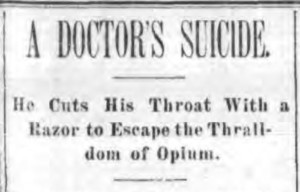 Opium was also used by physicians as a pain killer, and many doctors themselves fell prey to the grip of the powerful drug.
Opium was also used by physicians as a pain killer, and many doctors themselves fell prey to the grip of the powerful drug.
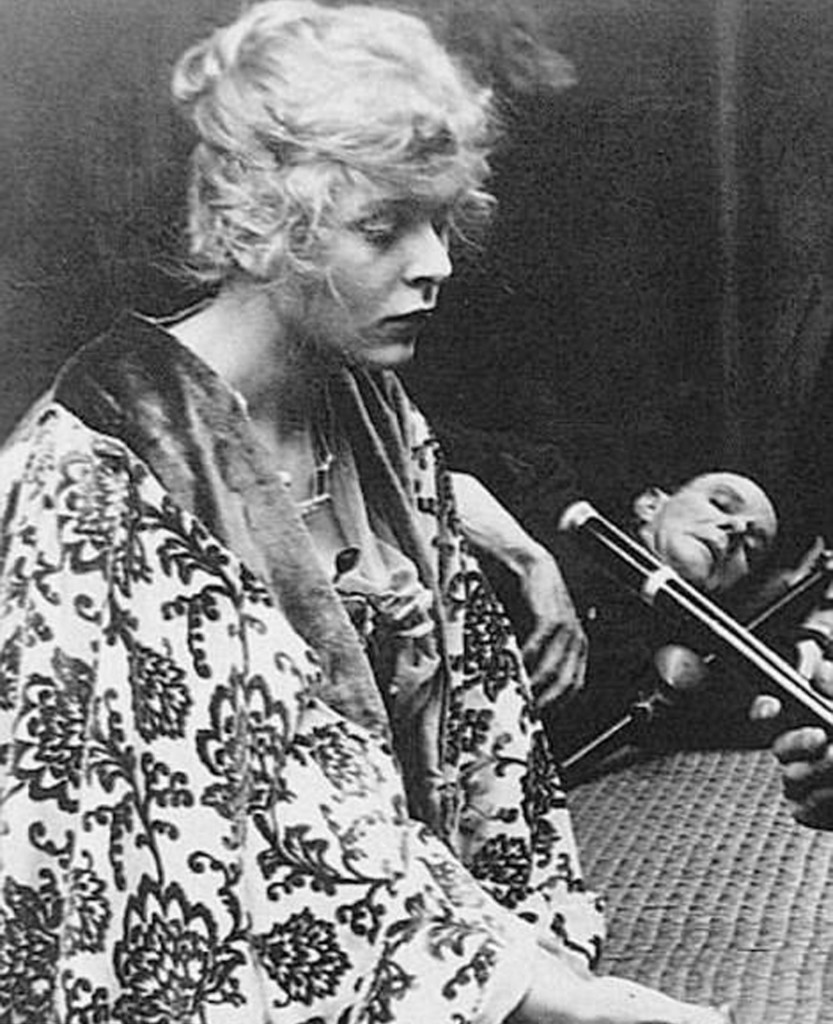 The highly addictive drug ruined the lives of Americans of all walks of life and all across the nation. The opium epidemic fanned the flames of hatred for the Chinese, who were blamed for bringing this evil drug with them to the States.
The highly addictive drug ruined the lives of Americans of all walks of life and all across the nation. The opium epidemic fanned the flames of hatred for the Chinese, who were blamed for bringing this evil drug with them to the States. 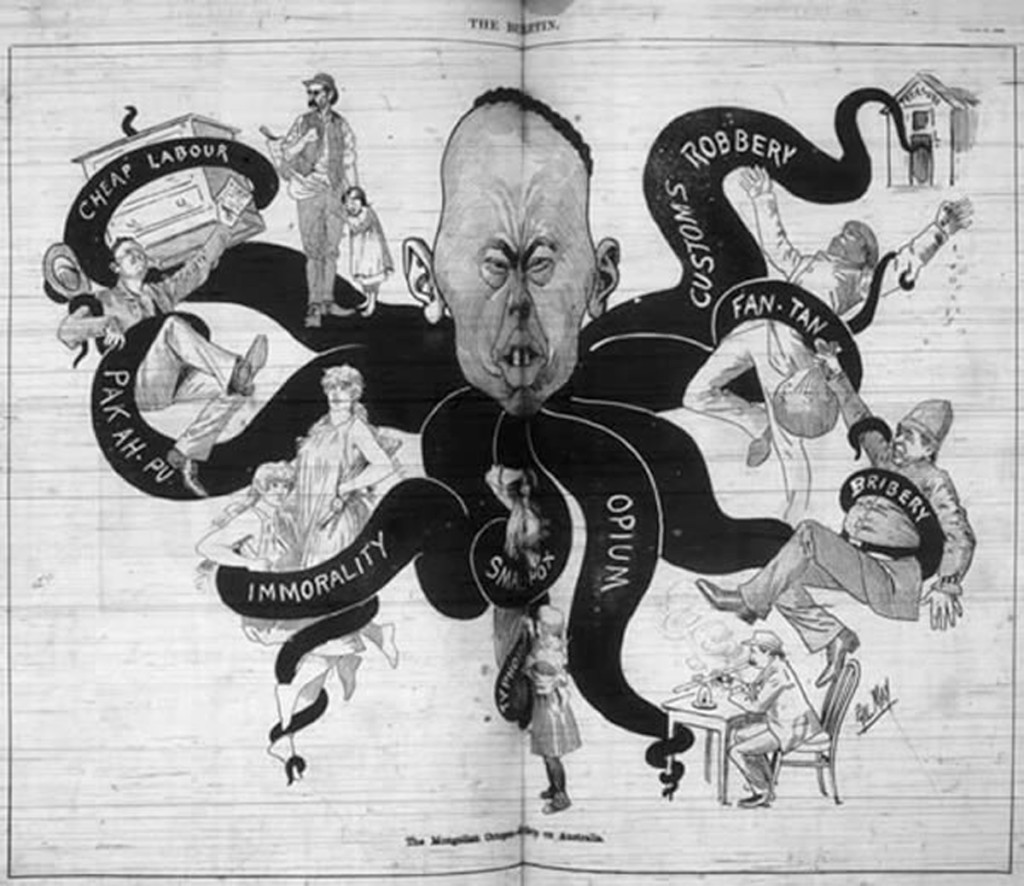 In 1882, Congress passed “The Chinese Exclusion Act”, riding the popular anti-Chinese sentiment and America’s fear of overpopulation. This was a major turning point for the U.S., which had previously welcomed all immigrants. This was followed in 1892 by the “Act to Prohibit the Coming of Chinese Persons into the United States”, a pretty self explanatory title.
In 1882, Congress passed “The Chinese Exclusion Act”, riding the popular anti-Chinese sentiment and America’s fear of overpopulation. This was a major turning point for the U.S., which had previously welcomed all immigrants. This was followed in 1892 by the “Act to Prohibit the Coming of Chinese Persons into the United States”, a pretty self explanatory title. And so began America’s illegal alien problem. Many Chinese continued to sneak across the border, mostly through Canada, but some tried the southern route through the deserts of Mexico.
And so began America’s illegal alien problem. Many Chinese continued to sneak across the border, mostly through Canada, but some tried the southern route through the deserts of Mexico. The strict new immigration laws created a whole new black market for inexpensive laborers. This entailed the smuggling of Chinese workers into the U.S. The news was full of smugglers and there were reports of aliens being brought from Mexico to California via ships landing near Santa Barbara.
The strict new immigration laws created a whole new black market for inexpensive laborers. This entailed the smuggling of Chinese workers into the U.S. The news was full of smugglers and there were reports of aliens being brought from Mexico to California via ships landing near Santa Barbara.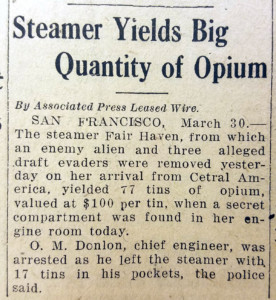
And opium just kept getting more popular, with smugglers getting busted left and right. All this was happening around the time of Doctor Winchester’s mysterious activities.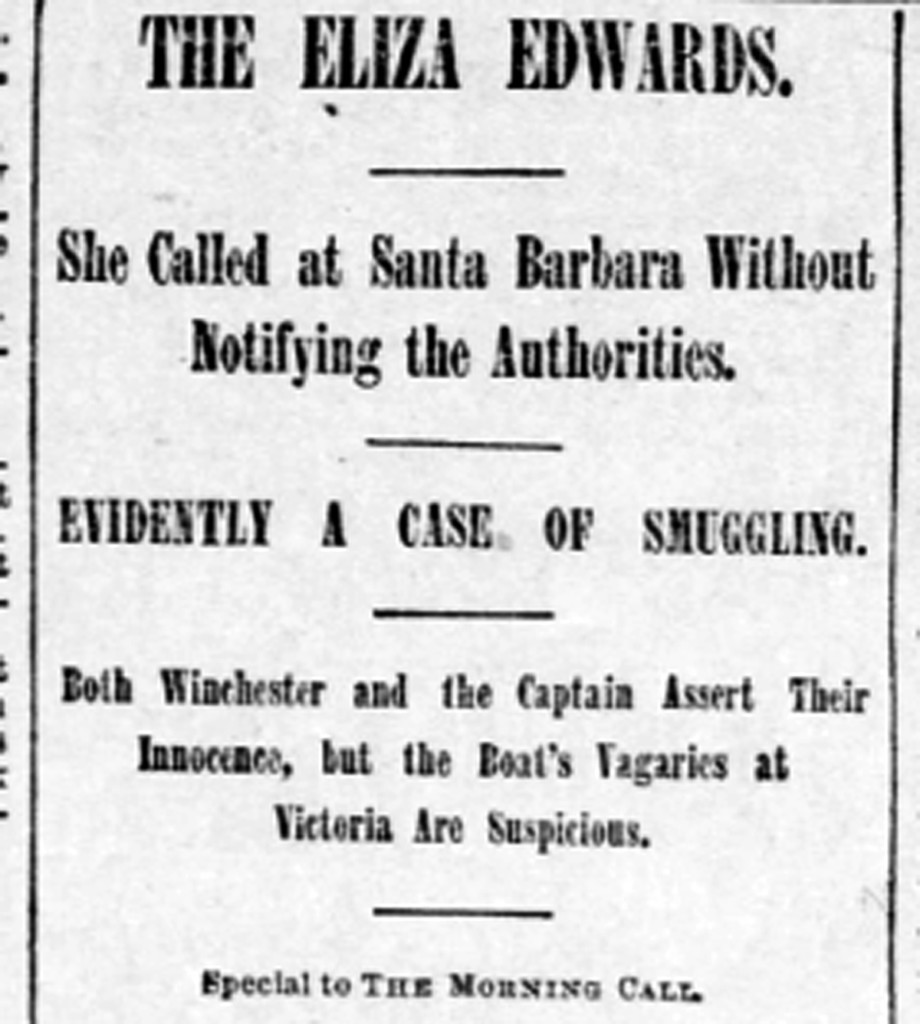 So the press, and the authorities, were both ready to jump to the seemingly obvious conclusion. But Winchester maintained his innocence, despite articles like this one from the San Francisco Call, that said the Eliza Edwards had allegedly smuggled 51 Chinamen and 2000 pounds of opium from Vancouver. The article also stated that Winchester and Captain Van Bremer had attempted to bribe a reporter to keep the story quiet.
So the press, and the authorities, were both ready to jump to the seemingly obvious conclusion. But Winchester maintained his innocence, despite articles like this one from the San Francisco Call, that said the Eliza Edwards had allegedly smuggled 51 Chinamen and 2000 pounds of opium from Vancouver. The article also stated that Winchester and Captain Van Bremer had attempted to bribe a reporter to keep the story quiet. Customs officials were shocked to find nothing illegal on the Eliza Edwards. No sign of the 51 Chinese laborers and none of the 2000 pounds of opium. They came to the obvious conclusion that the illegal merchandise had been dropped at Santa Barbara. Winchester had left on the first train back to Santa Barbara that morning, supposedly to destroy all the evidence there. Captain Van Bremer admitted the ship did stop in Santa Barbara, but only to take on fresh meat and a patent log. Van Bremer was charged a $1400 fine for not reporting the landing to authorities and the ship’s cook was arrested, with the hopes of him turning State’s evidence.
Customs officials were shocked to find nothing illegal on the Eliza Edwards. No sign of the 51 Chinese laborers and none of the 2000 pounds of opium. They came to the obvious conclusion that the illegal merchandise had been dropped at Santa Barbara. Winchester had left on the first train back to Santa Barbara that morning, supposedly to destroy all the evidence there. Captain Van Bremer admitted the ship did stop in Santa Barbara, but only to take on fresh meat and a patent log. Van Bremer was charged a $1400 fine for not reporting the landing to authorities and the ship’s cook was arrested, with the hopes of him turning State’s evidence.
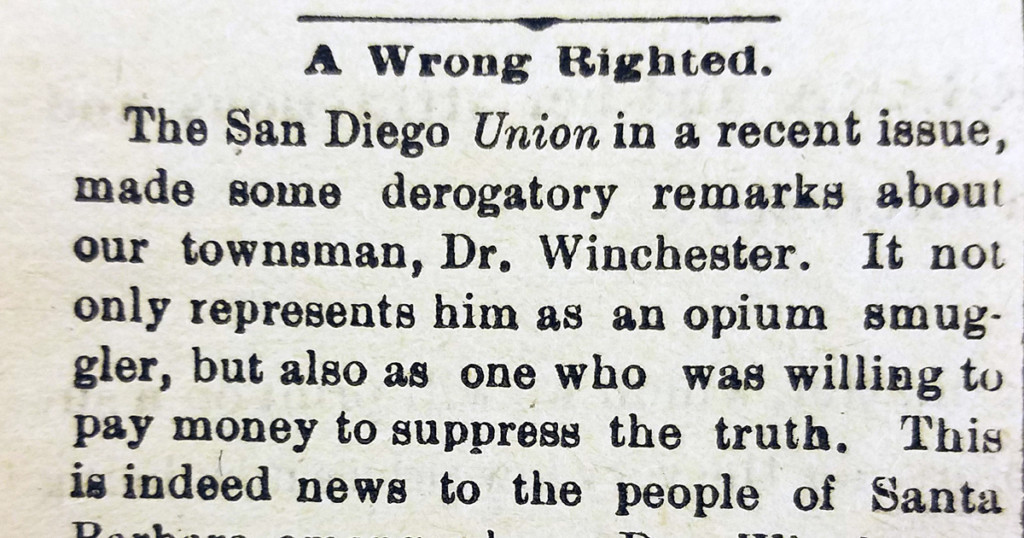
Locally, the Santa Barbara Morning Press vigorously defended the honor of Dr. Winchester. They printed several long explanations, directly from the doctor, in an effort to clear his good name.
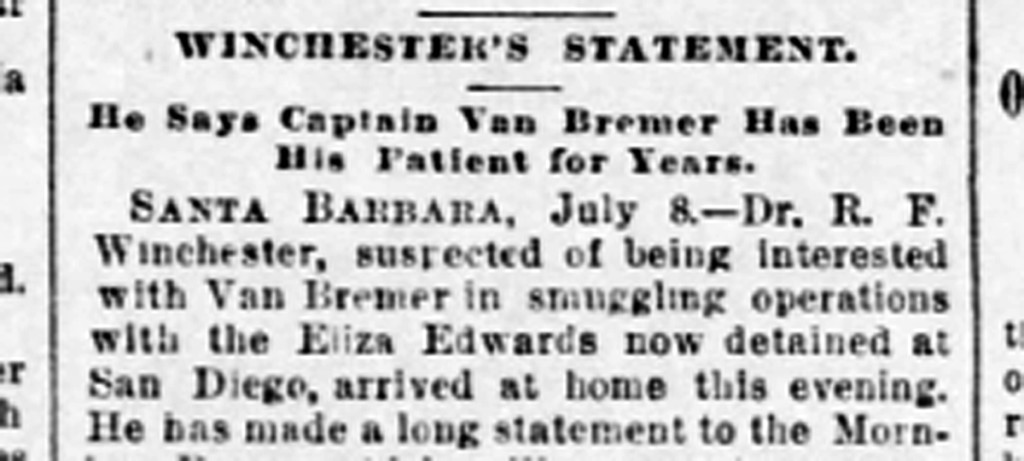 Winchester told the Morning Press that Captain Van Bremer had been a patient of his for years, and the purpose of the Eliza Edwards coming down the coast was partially to take the Captain on a sea cruise for his health. The other reason was to sell the vessel. Winchester said he was heading East when he heard the ship had been detained, so he went to San Diego to help his friend out. He registered under a false name to avoid the persistent reporters and customs officers. He emphatically denied offering money to the San Diego Union to suppress news. He also denied the rumor that the secret mission of the trip was to search for lost treasure at Cocos island….
Winchester told the Morning Press that Captain Van Bremer had been a patient of his for years, and the purpose of the Eliza Edwards coming down the coast was partially to take the Captain on a sea cruise for his health. The other reason was to sell the vessel. Winchester said he was heading East when he heard the ship had been detained, so he went to San Diego to help his friend out. He registered under a false name to avoid the persistent reporters and customs officers. He emphatically denied offering money to the San Diego Union to suppress news. He also denied the rumor that the secret mission of the trip was to search for lost treasure at Cocos island….
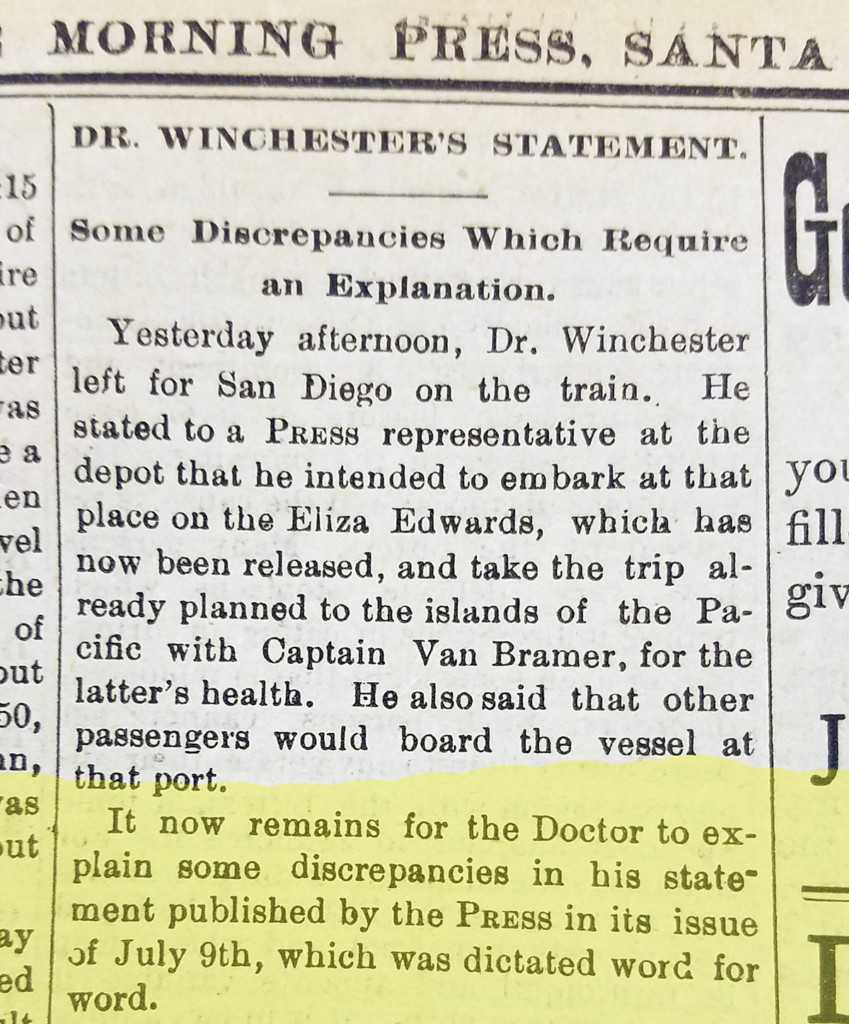 But there were still inconsistencies in his story. And every interview he gave, just confused the public even further. Soon, even the local press became suspicious.
But there were still inconsistencies in his story. And every interview he gave, just confused the public even further. Soon, even the local press became suspicious. On July 12th, Winchester boarded the Eliza Edwards and set sail, but for where, it still wasn’t clear. The Santa Barbara press was frustrated with the ever changing stories, and quipped that even the Eliza Edwards probably didn’t know where she was headed!
On July 12th, Winchester boarded the Eliza Edwards and set sail, but for where, it still wasn’t clear. The Santa Barbara press was frustrated with the ever changing stories, and quipped that even the Eliza Edwards probably didn’t know where she was headed! Captain Van Bremer did his part in confusing the story further. He paid the fine cheerfully, and took out clearance papers for hunting and fishing. The charges of smuggling were dismissed for want of actual proof. Van Bremer, however, added to suspicions when he changed his story about the ship’s final destination. Initially he said he was headed to Mexico and Central America, but now he insists he was headed for the Sandwich Islands on the advice of his physician. All signs pointed to the guilt of these two gentlemen, the only thing missing was the evidence. Their erratic behavior and inconsistent stories made them look very guilty, but there was no smoking gun, so the officials could not act.
Captain Van Bremer did his part in confusing the story further. He paid the fine cheerfully, and took out clearance papers for hunting and fishing. The charges of smuggling were dismissed for want of actual proof. Van Bremer, however, added to suspicions when he changed his story about the ship’s final destination. Initially he said he was headed to Mexico and Central America, but now he insists he was headed for the Sandwich Islands on the advice of his physician. All signs pointed to the guilt of these two gentlemen, the only thing missing was the evidence. Their erratic behavior and inconsistent stories made them look very guilty, but there was no smoking gun, so the officials could not act. A few months later, Winchester was in the news again, upon the return of their extended cruise. The doctor refused to be interviewed, and would only say that they had sailed in southern waters. He again insisted they had not gone to Cocos Island to search for treasure. Who kept bringing up the Cocos Island anyway?
A few months later, Winchester was in the news again, upon the return of their extended cruise. The doctor refused to be interviewed, and would only say that they had sailed in southern waters. He again insisted they had not gone to Cocos Island to search for treasure. Who kept bringing up the Cocos Island anyway?
Despite his denial, the article ends with this..

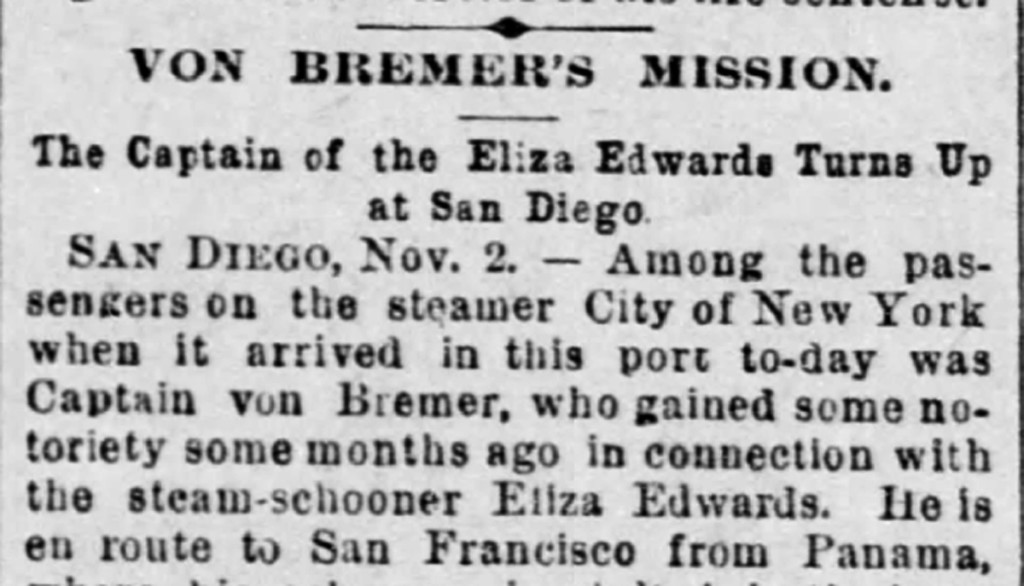 About a month later, Captain Van Bremer reappeared in San Diego, and in the news, where he proceeded to describe his current project, digging for buried treasure on, yep, Cocos Island. Other passengers from the Eliza Edwards were interviewed and told of a medium being on the trip, and her communications with spirits of pirates were supposed to pinpoint the location of the hidden treasure.
About a month later, Captain Van Bremer reappeared in San Diego, and in the news, where he proceeded to describe his current project, digging for buried treasure on, yep, Cocos Island. Other passengers from the Eliza Edwards were interviewed and told of a medium being on the trip, and her communications with spirits of pirates were supposed to pinpoint the location of the hidden treasure.  The story goes on to say how the whole story is of a “flimsy character” and was clearly fabricated to cover up the captain’s smuggling operations. Then it goes on to restate how guilty the captain and the doctor were, and how they got away with smuggling. The article ends with the assumption that Van Bremer is heading north “to resume his illicit traffic in a new vessel.”
The story goes on to say how the whole story is of a “flimsy character” and was clearly fabricated to cover up the captain’s smuggling operations. Then it goes on to restate how guilty the captain and the doctor were, and how they got away with smuggling. The article ends with the assumption that Van Bremer is heading north “to resume his illicit traffic in a new vessel.”
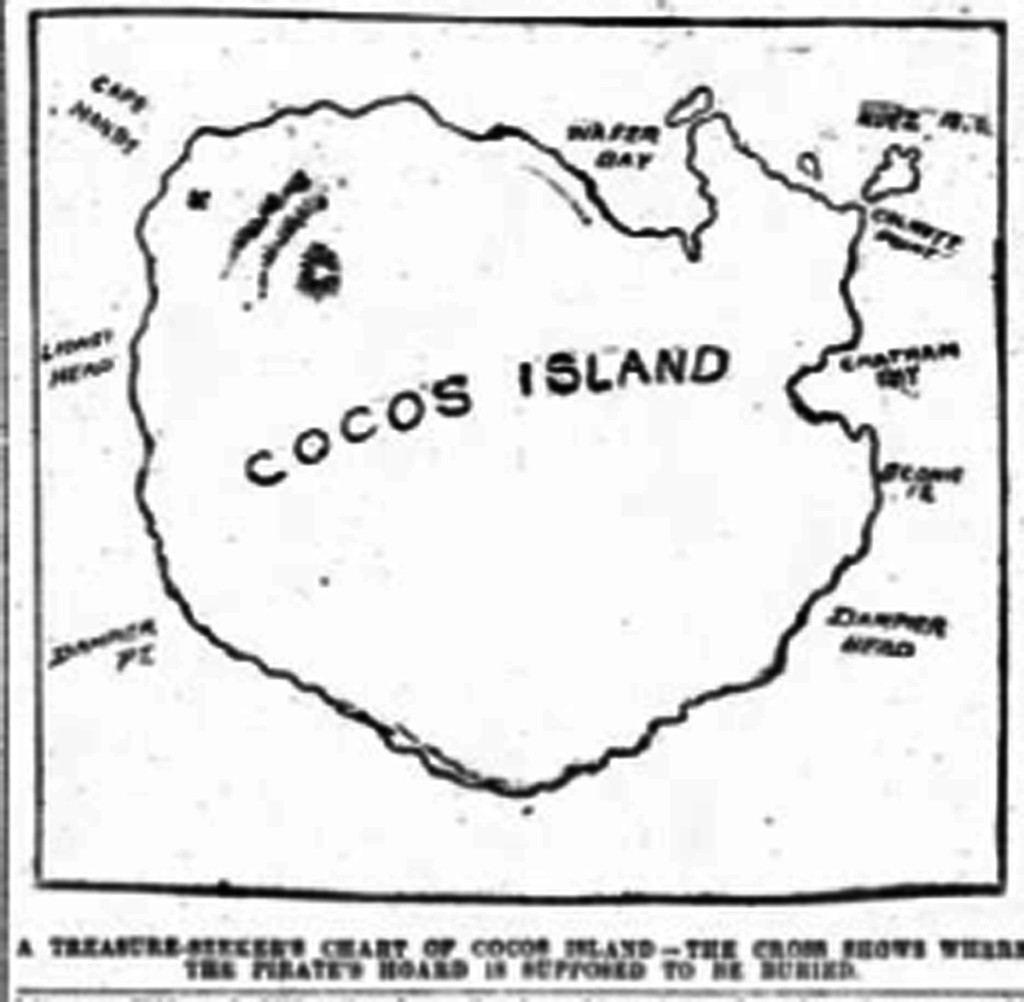 The Cocos Island story didn’t go away. In fact, several other expeditions went to the little island off of Costa Rica searching for treasure.
The Cocos Island story didn’t go away. In fact, several other expeditions went to the little island off of Costa Rica searching for treasure.
In 1894, the San Francisco Chronicle published a huge story about the Winchester/Van Bremer expedition to Cocos Island, calling it ‘The Truth about the Eliza Edwards”. The article details how the two upstanding gentlemen never did anything wrong, and how the press jumped to wild conclusions.  It called the expedition a “delightful lark” and gave every little detail of their activities on the island. Describing their merry pranks and detailed fun little stories, like how they befriended a small wild pig and named him “Dick”. This should have cleared up any questions about the suspicious activities of Winchester and Van Bremer, once and for all. But did it?
It called the expedition a “delightful lark” and gave every little detail of their activities on the island. Describing their merry pranks and detailed fun little stories, like how they befriended a small wild pig and named him “Dick”. This should have cleared up any questions about the suspicious activities of Winchester and Van Bremer, once and for all. But did it?
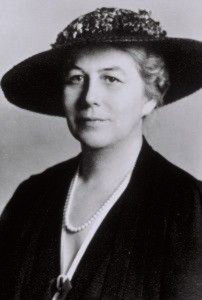
Years later, Walker Tompkins writes how Pearl Chase suspected that Dr. Winchester was a drug addict. Could this have been due to his mysterious activities with the Eliza Edwards in 1892? Perhaps. Or maybe just because so many physicians of that era were addicted to their own prescriptions?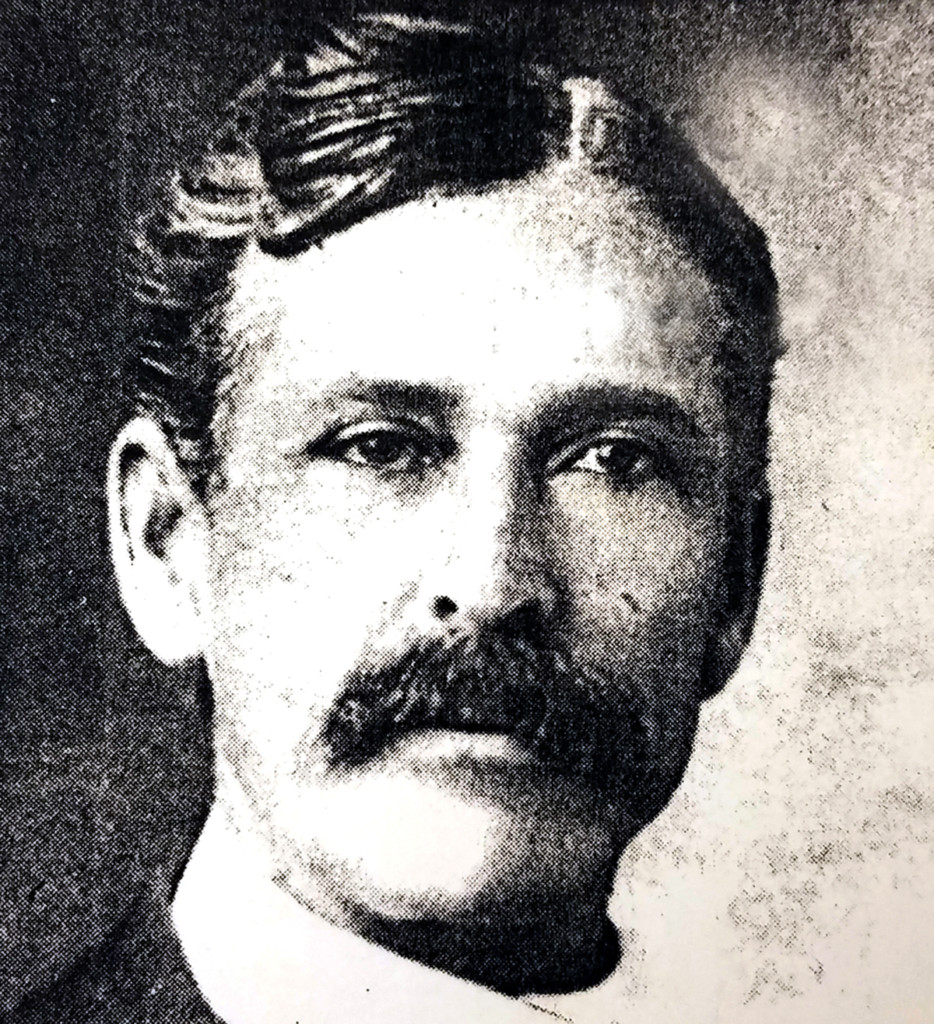
We can only speculate. Was Winchester involved in a smuggling operation that nearly got uncovered by Federal agents? Was it all just a sloppy attempt to keep a search for buried treasure secret? Why the secret stops at Santa Barbara and Victoria? Was the press on to something, or was it just an early version of “fake news”? For now, only the good doctor knows for sure…
Sources: Civil War Rx Blog, Los Angeles Times, San Diego history.org, News Dog Media, Galveston History.org, San Francisco Chronicle, San Francisco Call, Los Angeles Herald, Dive the world.com, Michael Redmon, New York Times, Santa Barbara Historical Society, Walker Tompkins, Newspapers.com
Categories: Goleta History
Holy cow, Tom. You really dug deep this time. Thanks for another great local story. This one has relevance way beyond just Goleta/Santa Barbara history.
Thanks Justin.
oh my gosh I just looked up Dr Winchester because I recently came across an original prohibition prescription for whiskey from Santa Barbara dated 1924 and signed by the good doctor RJ Winchester
what a fantastic story!
Nice! Glad you found it! Check this one out for more Winchester info….https://goletahistory.com/winchesters-secrets/
Tom,
I just came across your article, while doing family research. My Second Great Grandfather was a close associate of Captain Van Bremer AKA Van Braemer. They met in BC Canada at the Moodyville sawmill. Philander Swett was a part of the Moodyville Sawmill. He died in 1893 after he and a group of associates, became fabulously wealthy… supposedly Philander accumulated this wealth whil working as a manager at the mill. I cried foul on that, and suspected for years that they were part of the Opium smuggling. Several locations seem to have been identified for offloading their “goods”. Philander found his way to Ladners landing with a large vessel and a dock, to Oyster Bay, Golds beach in Oregon. It appears the Van Bremer made his way to the California drop spots. He owned a “boarding house”, where my great Grandmother can be found in 1890 working for him, in spite of the fact that Van Bremer was supposed to be the executor of Philander’s estate. Sarah knew these men intimately and trusted him, only to see every last bit of an estate estimated at over a million dollars disappear before her eyes.
I chased Van Bremer because of the belief that his “Katzie Indian wife” in Moodyville who he abandoned with one of his three daughters was related to Philander Swett’s wife, a 3/4 Hawaiian Indian woman. who died in about 1888. supposedly the two older girls were taken to Santa Barbara, so I have been looking for any traces of his daughters to see if they may be related.
It appears Winchester was the focus of your research, but I was hoping there may be more information on the Captain that you did not include. Philander was also in Santa Barbara for a brief time before 1860 while he made his way north to Oregon, then Victoria in 1860 where he may have met Van Bremer who supposedly found his way to Victoria and was naturalized there.
Wow, this is amazing! I didn’t find much on the Captain, but your info makes my think the good Doctor was up to no good! I’ll forward any info on the Captain I have. Thank you for writing!
Wow, this is amazing! I didn’t find much on the Captain, but your info makes me think the good Doctor was indeed up to no good! I’ll forward any info on the Captain I have. Thank you for writing!
Wow! Great work, Tom! I loved the images of the news stories for evidence and the photos of the opium addicts were amazing. Thanks. — Hattie
Thanks Hattie!
I stumbled across the great history on Winchester while researching the origins of Sadie A. Winchester.
I have an 1873 letter she wrote to a friend or family member back in Maine.
She describes how she used to be a teacher and how much she hated it and wasted her life doing it. she’s definitely living in Santa Barbara at this time, as I have the original envelope with a June 10th 1873 Santa Barbara cancel on it.
It’s quite a long letter and there’s some interesting local history about picking blackberries and doing some fishing and her fears a mountain lions and grizzly bears in the area. She does reference a steamer coming to town and a few other things but I did not see a Sadie connected to Dr Winchester in any other way.
If anyone happens to know who she is, I’d be curious and if someone wants to see some photos of the letter I’d be happy to share as well. Thanks, Eric